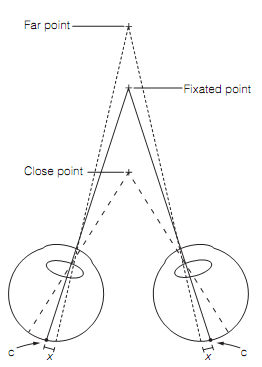Depth perception
The retinal image is 2-dimensional, but from the visual system can infer the 3-dimensional structure of the world. There are both monocular and binocular cues to the depth perception. The Monocular cues are most significant for distant objects, where binocular cues cannot be used, and involve the illustrations shown below:
- The Movement of the causes an apparent movement for near objects with respect to distant ones; the closer the object the bigger the apparent movement.
- The Parallel lines look to converge with distance (geometric perspective); artists from the early 1400s onwards used this as a main depth cue in painting.
- The associative sizes of objects of known dimensions.
- The More distant objects can be partially hidden by the nearer ones (occultation).
- The Distant objects are faded and bluer as of intervening haze (extinction).
- The capability to solve fine detail falls off with the distance.
- The Neural signals which correspond to how much the visual system has had to change the shape of the lens to keep the object in focus.
The binocular cue to depth perception is known as the stereopsis. As the eyes are about 6.3 cm apart each has a little dissimilar view of the world. (This can be seen by viewing a scene first through one eye, then by the other, whenever nearby objects look to jump sideways; binocular parallax.) This has the effect that the image of a nearby object falls onto diverse horizontal positions on the left and right retinas, a phenomenon known as retinal (binocular) disparity. Whenever the eyes converge to fixate on a nearby point the two retinal images of the point are perceived as fused into a single point. All the other points at the similar distance are fused as their images lay at similar corresponding positions on left and right retinas. The Points in space which lie either closer or further away than these will form images at various corresponding retinal positions and therefore different binocular disparities as shown in figure. The closer the object is, the bigger the disparity. The Images of these points will also fuse supplied that disparity is not too great (> 0.6 mm or 20). Beyond this either the two images are seen, the double vision (diplopia), or information from one eye is entirely rejected by the visual cortex. Clearly the stereopsis is only possible for the field of view in which the two monocular visual fields overlap. The brain is capable to calculate depth from disparity simply by comparing where the similar pattern lies on the left and right retinas. The Stereopsis does not need form, movement, or color.

Figure: Stereopsis.